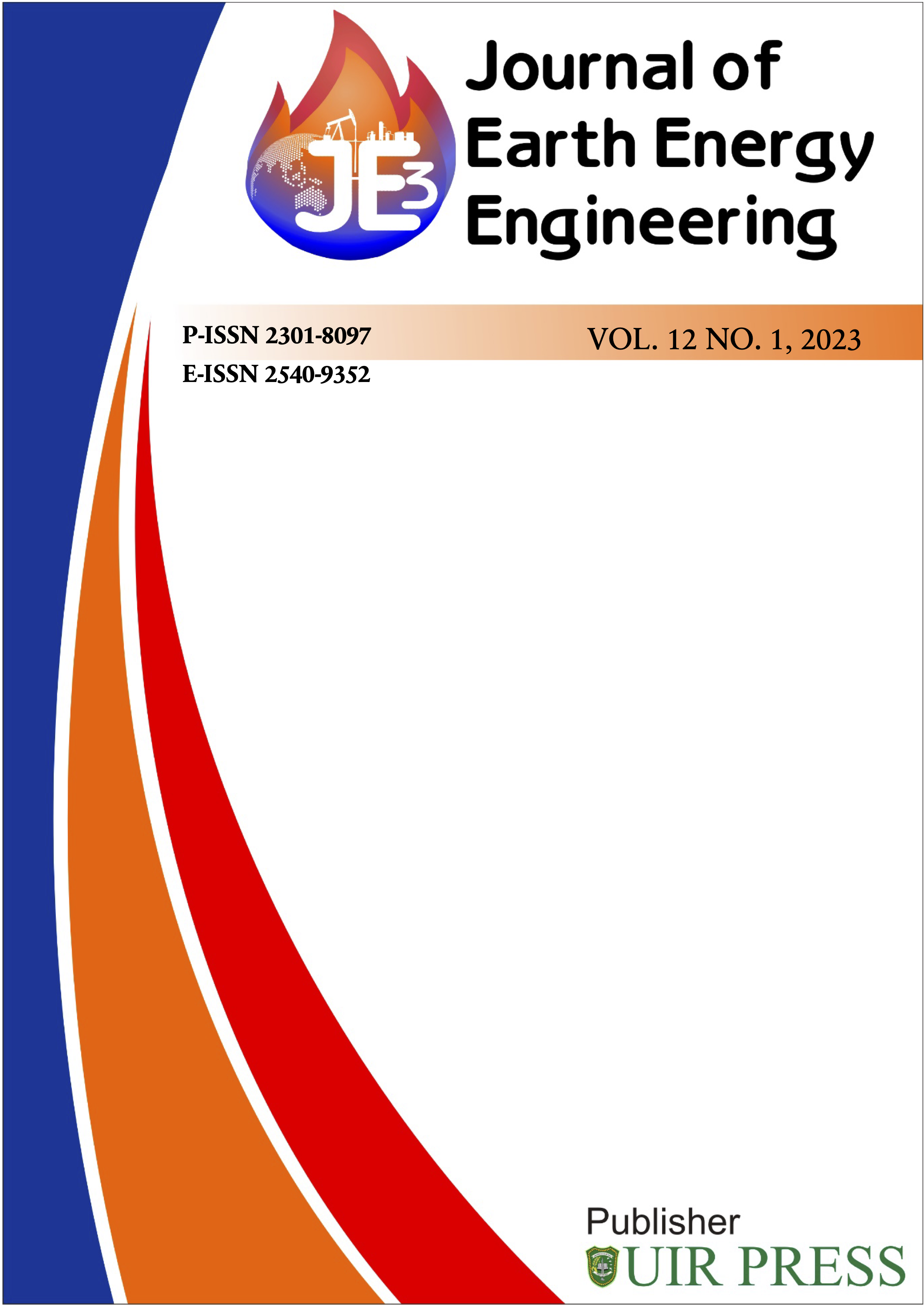Analysis of Liquid Loading and Sandness in Gas Wells A1, A2 And Their Correction with The Plunger Lift Method in Field B
Abstract
The inability of the gas to lift liquid to the surface causes liquid to accumulate in the downhole, this event is called liquid loading, and sand deposits at the bottom of the well are caused to be swept away by the gas flow. If a well has liquid loading and sandification, well production will decrease and even the well will die. For this reason, it is necessary to carry out a predictive analysis of the well and a method to overcome the problem of liquid loading and sandiness using a plunger lift.
Liquid loading is not always easy to identify, because the well is still producing significantly. The method used in the petroleum world to identify liquid loading is the "Turner et al" method. The plunger is a piston-type device that moves freely in the tubing and according to the inside diameter of the pipe, rising when the well pressure is sufficient to lift it and moving back down due to the force of gravity. The plunger lifting system uses gas pressure buildup in the well to lift the accumulated liquid column out of the well. The researcher conducted a liquid loading analysis on well A1 and well A2. From the results of the study it was identified that well A1 did not experience liquid loading, because the calculation results showed that the well's critical gas flow rate was 3.3 MMSCFPD which was less than the actual gas flow rate of 5 MMSCFPD. Well A2 is experiencing liquid loading, because the results of the calculation of the well's critical gas flow rate are 3.6 MMSCFPD, while the actual gas flow rate in the field is 3MMSCFPD.
After removal of fluid and sand from the bottom of the well, the production rate of the A2 gas well increased to 5 MMSCFPD.
Full text article
References
Akhir, T., & Akmal, M. (2010). Integrasi Sistem Reservoir , Sumur , dan Pipa Produksi Perkiraan Liquid Loading Sumur Gas
Canyon Hydro, et all (2013). We are IntechOpen , the world ’ s leading publisher of Open Access books Built by scientists , for scientists TOP 1 %. Intech, 32(July), 137–144.
Gasbarri, S. (1996). Development of a plunger lift model for gas wells.
Gasbarri, S., & Wiggins, M. L. (2001). A Dynamic Plunger Lift Model for Gas Wells. SPE Production and Facilities, 16(2), 89–96.
Guo, B., Ghalambor, A., & Xu, C. (2005). A systematic approach to predicting liquid loading in gas wells. Society of Petroleum Engineers - SPE Production Operations Symposium 2005, POS 2005, 1, 1–9.
Hashmi, G. M., Hasan, A. R., & Kabir, C. S. (2016). Design of plunger lift for gas wells. Society of Petroleum Engineers - SPE North America Artificial Lift Conference and Exhibition 2016, October, 25–27.
Herrera Marcano, T., Cachada, A., Rocha-santos, T., Duarte, A. C., & Roongtanakiat, N. (2009). Overview OfSolution to prevent Liquid Loading Problems In Gas Well A.
J, M. F. K., Kartoatmodjo, R. S. T., & Wati, K. F. (2017). Analisa Liquid LoadingPada Sumur Gas FJRN-1. 179–182.
Junior, J. M. D. J., & Simonelli, G. (2018). Open Access Conventional Plunger Lift Designusing Excel ®American Journal of Engineering Research ( AJER ). 10, 255–263.
Lea, J. F., U, T. T., & Nickens, H. V. (2004). Solving Gas Well Liquid Problem. Distinguished Author Series, April, 30–36.
Liu, X., Falcone, G., & Teodoriu, C. (2017). Liquid Loading in Gas Wells : from Core-Scale Transient Measurements to Coupled Field-Scale Simulations 1 Introduction. 157(August), 1056–1066.
Maddox, R. N., Moshfeghian, M., Ldol, J. D., & Johannes, A. H. (2010). Natural Gas : Natural Gas : The New York Times, May, 27–30. https://doi.org/10.5772/9804
Musnal, A. (2018). Perhitungan Laju Aliran Fluida Kritis Untuk Mempertahankan Tekanan Reservoir Pada Sumur Ratu Di Lapangan Kinantan. 1–8.
Nallaparaju, Y. (2012). Prediction of Liquid Loading. 9th Biennial International Conference & Exposition on Petroleum Geophysics, p--446.
O, Divyakumar. GARg, B. . (2004). new modeling techniques for two-pieces plunger lift components.
Park, H. Y., Falcone, G., & Teodoriu, C. (2009). Decision matrix for liquid loading in gas wells for cost/benefit analyses of lifting options. Journal of Natural Gas Science and Engineering, 1(3), 72–83.
Sankar, S., & Arul, S. (2019). Study of Identifying Liquid Loading in Gas Wells and Deliquification Techniques. International Journal of Engineering Research & Technology (IJERT), 8(06), 1434–1445.
Sask, D., Kola, D., & Tuftin, T. (2010). Challenges Challenges to Liquid Unloading in Horizontal Wells Check Valve Limitations in Horizontal Wells Plunger Efficiencies in Horizontal Wells.
Authors
This is an open access journal which means that all content is freely available without charge to the user or his/her institution. The copyright in the text of individual articles (including research articles, opinion articles, and abstracts) is the property of their respective authors, subject to a Creative Commons CC-BY-SA licence granted to all others. JEEE allows the author(s) to hold the copyright without restrictions and allows the author to retain publishing rights without restrictions.




